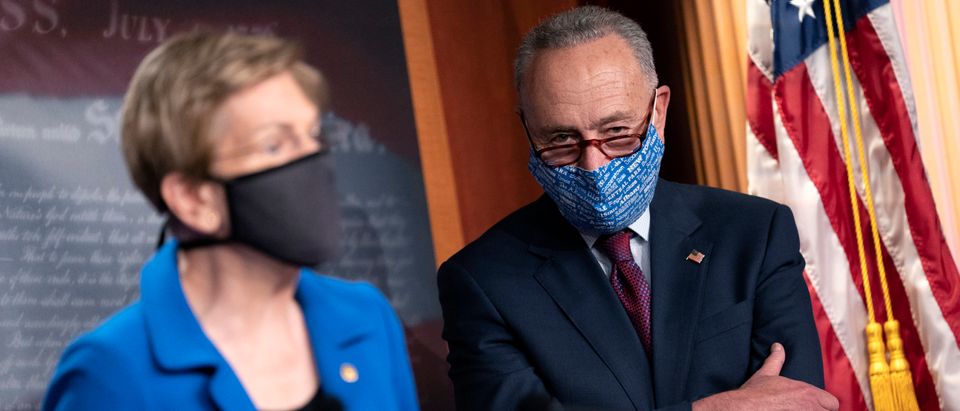President-elect Joe Biden, who promised to relieve some student loan debt on the campaign trail, is facing growing calls from fellow Democrats and activists to do so via executive order soon after taking office.
Biden’s campaign plan called for the elimination of $10,000 in student loan debt for any American who had it, with further reductions for graduates of public colleges or historically black colleges and universities making less than $125,000 per year, per CNBC.
With Democrats needing to win both runoff elections in Georgia to secure a 50-50 tie in the United States Senate, some within the party have begun advocating for steps Biden might be able to take without the help of congress. (RELATED: America’s Biggest Teachers Union Shakedowns)
Democratic Senator Elizabeth Warren said in a Washington Post op-ed that the Biden-Harris administration should eliminate billions of dollars in student debt via executive action on day one. She joined Senate Minority Leader Chuck Schumer and 11 other Democrats to introduce a resolution in September calling for the next President to eliminate $50,000 of student debt per borrower with executive action, according to the Wall Street Journal.
New York Representative Alexandria Ocasio-Cortez also argued the Biden administration could take action without needing Senate approval in an Instagram video. However, not all experts agree on whether it would be legal for Biden to make a move on student loan debt without passing it through congress first.
Some have cited President Donald Trump’s actions to suspend student debt payments due to the pandemic as evidence that Biden could take similar action to relieve debt, but higher education expert Mark Kantrowitz told the WSJ that Trump’s order could have been stopped by a court challenge, believing it to have been illegal. He says that while “nobody was going to do that” to stop the loan suspensions, Republicans likely would sue to stop full-blown debt forgiveness.
Thank you for sharing your story, @rgay.
Student loan debt is an anchor on our struggling economy, holding entire generations back.
Now is not the time for half-measures. Now is the time for bold investments in our future. https://t.co/GIuJZYwzeB
— Elizabeth Warren (@ewarren) November 20, 2020
University of Chicago law professor Ryan D. Doerfler told CNBC that legal opponents may say the executive branch can only relieve debt for certain people or certain situations, limiting the scope of Biden’s potential action. (RELATED: Teachers Unions And Biden: What To Expect For The Next 4 Years)
A theory posited by some Democrats contends that the Department of Education can relieve student loan debt through the Higher Education Act of 1965. A paper published by Yale Law School PhD student Luke Herrine is often cited, in which he says “The Department of Education has already been given the authority “compromise, waive, or release” its claims against students, and nothing under current law clearly limits that authority.”
Even if Biden were able to relieve $10,000 of student loan debt without the approval of congress, opinion among experts and economists varies on how helpful that would be to the overall economy.
A study by the Levy Economics Institute found that relieving all student loan debt in America would create about 1 million new jobs per year and increase GDP by half a percent. More than 100 academics signed a letter last year endorsing Senator Bernie Sanders’ plan to relieve all student loan debt.
In a Washington Post op-ed, Adam Looney of the liberal Brookings Institution says that passing relief up to $10,000 is the right idea. He argues that a full elimination of student loan debt would most benefit workers “who have already tended to be winners in an economy marked by ever-rising inequality.” (RELATED: Biden Says His Priorities Are Citizenship For Illegal Immigrants, Overturning Trump’s Executive Orders Affecting Climate)
Matt Bruenig, president of the left-leaning People’s Policy Project, told The Hill that a student debt relief package may be Biden’s best way to pass a stimulus without needing congressional approval. However, Bruenig has also recently written “if we are being honest about things, student debt forgiveness is possibly the least effective stimulus imaginable on a dollar-for-dollar basis. Normal stimulus measures try to put money in people’s pockets so that they can spend it. But student debt forgiveness does not do this.”
Others, like Beth Akers of the conservative Manhattan Institute, say that a middling approach makes the most sense. In a recent WSJ op-ed, she points out that borrowers owing less than $5,000 are the most likely to default because they may not have finished their degree, and those with the most debt often have the highest-paying jobs as a result. For this reason, she says, Biden should aim for debt relief that caps at $5,000.
Of course, there are also those who oppose any kind of federal student loan debt elimination. Allison Schrager, also of the Manhattan Institute, writes that there are “better, cheaper ways to stimulate the economy.” Preston Cooper, who studies the economics of higher education and is formerly of the Manhattan Institute and the conservative-leaning American Enterprise Institute, says in Forbes that those with the most debt are people with graduate degrees, which grant higher earning power.
Cooper also points out that students from rich families actually tend to borrow more money than students from poor backgrounds. Debt erasure, even in limited form, is a poor form of economic relief, he says. “Out of 255 million adult Americans, just 45 million have federal student debt. If economic relief is in order, it’s highly inequitable to distribute tens of thousands of dollars to the 45 million while the other 210 million get nothing.” (RELATED: ‘We Don’t Know Where They Are’: Alabama Education Superintendent Says 5,000 Students Haven’t Shown Up For Classes)
Biden has called for congress to act to relieve $10,000 in student debt on multiple occasions. However, sources close to Biden reportedly told the New York Times that the president-elect still does not endorse taking such action via executive order.


